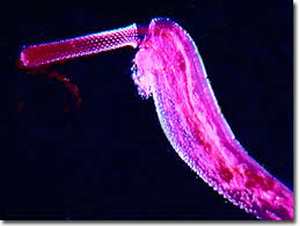

MedFriendly®


Acanthocephaliasis
Acanthocephaliasis is an illness caused by an infection
with a species of Acanthocephala (see picture to the
right). Acanthocephala is a group of worms that act as
parasites. A parasite is an organism that lives in or on
another organism to obtain nourishment. The main
sources of Acanthocephaliasis in humans are the
thorny-headed worms, Macracanthorhynchus
hirudinaceus and Moniliformis moniliformis. The former
is found in pigs and the latter is mostly found in rodents,
cats, dogs, and red foxes (in Poland). Both of these
worms use beetles as intermediate (temporary) hosts.
Acanthocephala
It is rare for humans to develop acanthocephaliasis but it can happen by consuming the
intermediate hosts (e.g., eating beetles and cockroaches). While most people from
Western countries would never consume such insects for cultural reasons, in some
countries such as Thailand and countries in Africa, consumption of these bugs is quite
common. In Western countries, some children with pica may consume such insects,
especially in areas with poor hygiene.
Pica is the developmentally inappropriate consumption of non-nutritive substances. Due
to the route of infection, awareness campaigns designed to teach people not to consume
such insects and maintaining good hygiene practices to prevent these bugs from entering
the home can reduce infection.
"Where Medical Information is Easy to Understand"™
Some human patients with acanthocephaliasis do not develop
symptoms. Of those that do, symptoms can include pain in the
abdomen, edema (swelling), diarrhea, dizziness, giddiness, and
anorexia (extreme weight loss). Acanthocephaliasis is treated with
anti-helminthics, which are drugs that rid worms from the body. The
names of such drugs include ivermectin, pyrantel parmoate,
mebendazole, and thiabendazole.
Acanthocephaliasis comes from the Greek word “akantha” meaning
“a thorn” and the Greek word “kaphale” meaning “head.” Put the
words together and you have “a thorn head.”
















